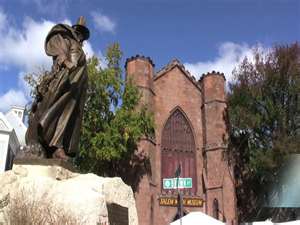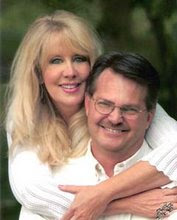Interesting development. In my last post I shared a story regarding Ann Alcock Foster, my 9th great-grandmother, an accused witch of the Salem Witch Trials. Well, today I found the story of Thomas Putnam, my 8th great-grandfather. He apparently was one of the top two persecutors of the witches, second only to the Reverend Parris.
My Father's dad, Leon Kemp was descended from Ann Alcock Foster, while my Father's mom, Ruth Gladys Russell was descended from Thomas Putnam. I wonder how Grandpa and Grandma really got along. :-)
I found the following accounts on Ancestry.com.
Sergeant Thomas Putnam, son of Lieutenant Thomas Putnam and his first wife Ann (Holyoke) Putnam; was born March 12, 1652 in Salem, Essex, Massachusetts. He died in Salem May 24th, 1699. He was well educated, yet took a prominent part in the witchcraft delusion, and was second to none but Reverend Parris in the fury with which he persecuted the victims of that strange delusion. He had great influence in the village and did not hesitate to use it. He had been in the Narragansett fight, belonging to a company of troopers, and was parish clerk. Many of the records of the witchcraft proceedings are in his fine, clear handwriting. His wife was also active in the persecutions. The strain was too great for him to bear up under, and he died shortly after the trials, his wife following him to the grave a few weeks later.
He married, September 25th, 1678, Ann, youngest daughter of George and Elizabeth Carr, of Salisbury. She was born June 15th, 1661, in Salisbury, Essex, Massachusetts. She died June 8th 1699 is Salem. They were the parents of twelve children: Ann, Thomas, Elizabeth, Ebenezer, Deliverance, Thomas, Timothy, Experience, Abigail, Susanna, Sarah and Seth.
Hudson-Mohawk Genealogical and Family Memoirs, Vol. I, pp. 345-348, edited by Cuyler Reynolds (New York: Lewis Historical Publishing Company, 1911)Reference collection of the Schenectady County Public Library at R 929.1 R45
Also found on Ancestry.com this account was written by Joseph Fore for his religion class.
Thomas Putnam
Written by Joseph Fore
RELG 415: Salem Witch Trials in History and Literature
An Undergraduate Course, Univeristy of Virginia
Fall Semester, 2006
"Thomas Putnam was a third generation member of Salem Village. He had many relatives in the area and they collectively owned a substantial amount of land in Salem Village and Essex County. Putnam was a Sergeant in the local militia and had fought in King Phillip's War (1675-1678) against native Indians and their French allies on the northeastern frontier. He was married to Ann Putnam Sr. (maiden name Carr), who came from a wealthy Essex County family.1
Sometime in January of 1691/1692 Ann Jr. began having fits along with other girls in Salem Village. By the end of February of that year, the girls claimed that the source of their affliction was witchcraft and made specific accusations against Sarah Good, Sarah Osborne and Tituba, an Indian slave of the Reverend Samuel Parris. Because the girls were not of legal age to make accusations, Putnam along with three other prominent men in Salem village filed official complaints on their behalf and sought warrants against the suspected witches on February 29, 1692. Immediately, the three women were arrested on suspicion of witchcraft, which was a capital offense, and were taken into custody.2
On April 21, 1692, with dozens of accused already in jail, Putnam wrote a letter to John Hawthorne and Jonathan Corwin, two of the judges of the examining magistrates in Salem who would later be appointed to the special court of Oyer and Terminer to try the accused witches. In that letter Putnam gave the honored judges a "most humble and hearty thanks" for the work they had done to root out evil in Salem. Putnam remarked that the judges had taken "great care and pains" to assist the people of Salem during this time of crisis. Putnam claimed that the people of Salem could never repay the judges for their remarkable actions. He assured the judges that "therefore a full reward will be given you of the Lord God of Israel, whose cause and interest you have espoused." Here Putnam was giving the legal proceedings against the witches a decidedly theological grounding. He was emphasizing the apocalyptic nature of the struggle in Salem. The Devil was attempting to spread evil in Salem, through his pact with the witches. In order to defeat Satan, good men like the judges were required to do God's work by seeking out those who had made a pact with the Devil. Putnam reminded the judges that their work for God's cause against Satan would only "add to [their] crown of glory in the day of the Lord Jesus." Here Putnam was making the argument that the judges would receive praise and reward when Jesus came for a second time and resurrected the souls of the faithful.
Yet despite the hard work of the judges, there remained work to be done. In his letter, Putnam wrote that he believed it his duty to inform them of a "high and dreadful" truth, "of a wheel within a wheel, at which [their] ears do tingle." The day before, on April 20th, his daughter had accused the Reverend George Burroughs of tormenting her. Burroughs was to be accused of being the ringleader of the witches in Salem. Putnam was referring to this greater conspiracy in this part of the letter. Putnam asked the judges to continue to pray for the community and offer their help and prayed to "almighty God continually to prepare [them]" for the work ahead. He hoped the judges would be a "a terror to evil-doers and a praise to them that do well" and offered his assistance to them in any way he might be able.3
In April, Putnam sent a second letter to Judge Samuel Sewall. In that letter he wrote that his daughter "was grievously tormented by witches, threatening that she should be pressed to death, before Giles Cory." Here Putnam was simultaneously arguing that witches were still at large in the community and that they were greatly angered by the trial of their fellow witches, like Giles Cory. Putnam claimed that his daughter had been visited by the specter of a person who had been pressed to death by Giles Cory and that that person had claimed that God desired Giles Cory to die in the same way that he had died. Here Putnam was arguing that God supported Cory's immediate death by pressing. Putnam then reminded Judge Sewall that some seventeen years past a man who lived with Giles Cory had "bruised to death." Putnam implies that Cory had to pay a large bribe to avoid prosecution in this case. Once again, in this letter, we see Putnam supporting the judges' actions and giving their work a theological basis, arguing that God supported their work.4
The question of Putnam's motives in furthering the trials has been taken up by many. In Miller's The Crucible, the Putnam's worried that several of their children might have been killed by witchcraft. In reality, the Putnam's had only lost one child, a girl named Sarah who died six weeks after birth in 1689.5 Ann Jr. accused John Willard of killing baby Sarah through witchcraft. Worry over the death of their baby daughter two years prior and the possibility that it may have been the result of witchcraft provides one explanation for the zeal that Putnam showed in attempting to providence against so many for the crime of witchcraft.
A recent handwriting analysis of the depositions of the afflicted girls has shown that some 122 of them were written by Thomas Putnam. While it cannot be known to what degree the accusations made in those depositions were influenced by Putnam it is clear that Putnam had the opportunity to shape the words of the young accusers as he saw fit. Further, the similarity in language across these depositions suggests that some of the language might be that of Thomas Putnam rather than that of the afflicted girls themselves.6 In the depositions taken by Putnam, the afflicted often claim to be "grievously afflicted" or "grievously tormented" and "believe in my heart" that so-and-so is a witch.
The accused are often referred to as "dreadful witches or wizards" in the depositions taken by Putnam. The frequency with which these phrases can be found in the depositions written by Putnam furthers the theory that they might have been more strongly influenced by Putnam that was previously recognized. Taken in conjunction with Putnam's letters to the judges and his efforts to secure warrants against many of the suspects, this new evidence further demonstrates the remarkable influence Putnam had on the shape and progression of the trials."
Endnotes
1. Mary Beth Norton In the Devil's Snare (New York: Alfred A. Knopf, 2002) 22.
2. Rosenthal Salem Story (Cambridge: Cambridge University Press, 1993) 14-15.
3. "Letter of Thomas Putnam to John Hathorne and Jonathan Corwin" in Salem Witchcraft Papers Vol. I Paul Boyer and Steven Nissenbaum ed. 165-166.
4. "Letter from Thomas Putnam to Judge Samuel Sewall" in Salem Witchcraft Papers Vol. I, 246.
5. Norton, Devil's Snare 157.
6. Peter Grund, Merja Kyto, and Matti Rissanen "Editing the Salem Witchcraft Records: An Exploration of a Linguistic Treasure" American Speech, Vol. 79 No. 2, Summer 2004, 158-159
Todos Hacks Inventados Para Minecraft
3 years ago







